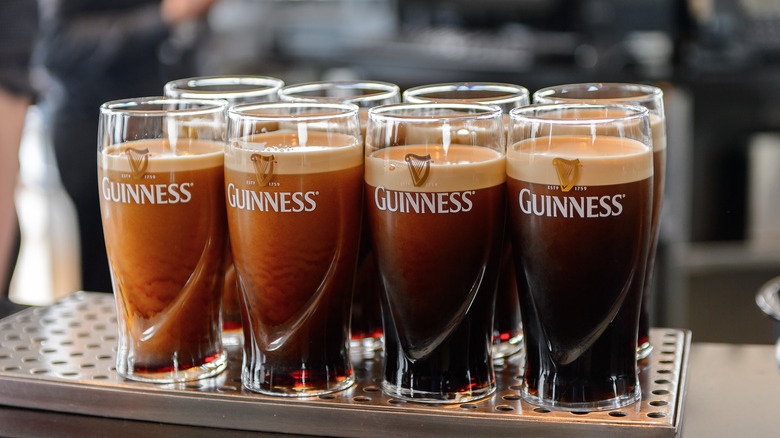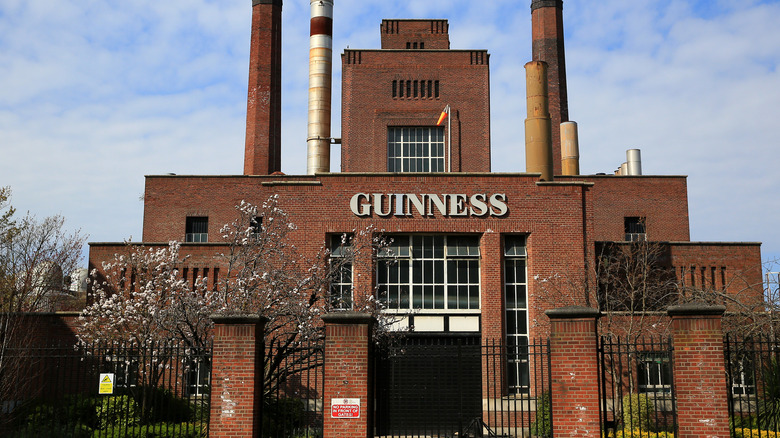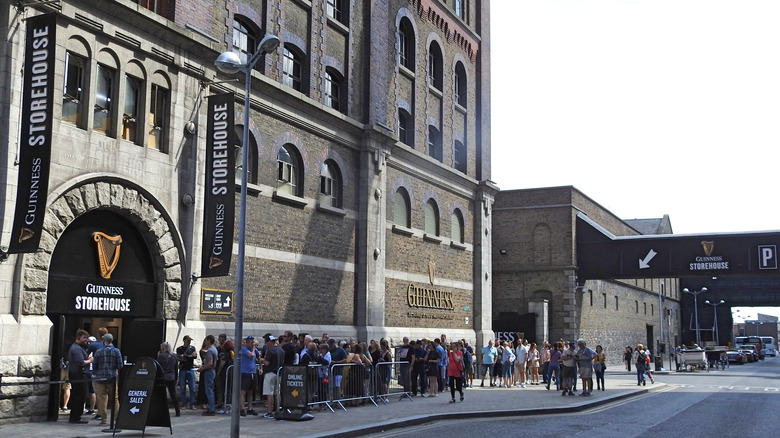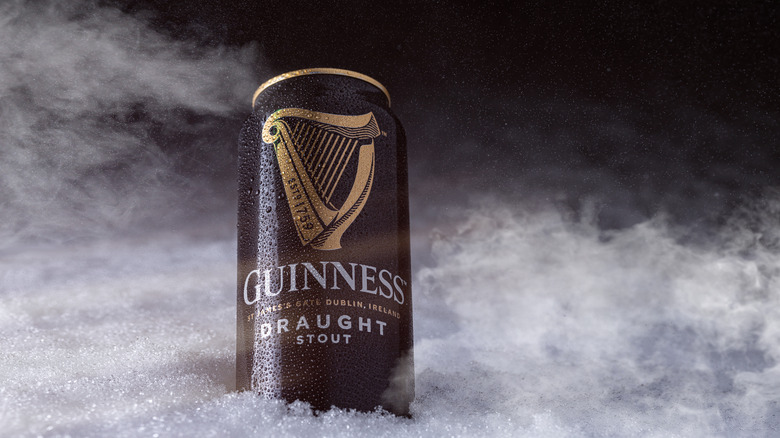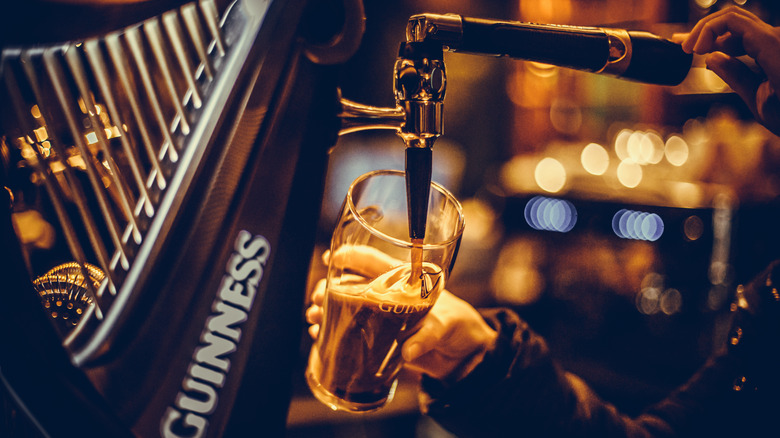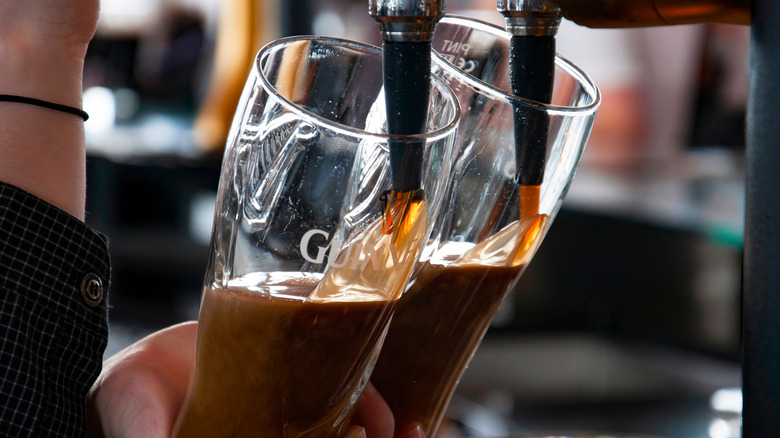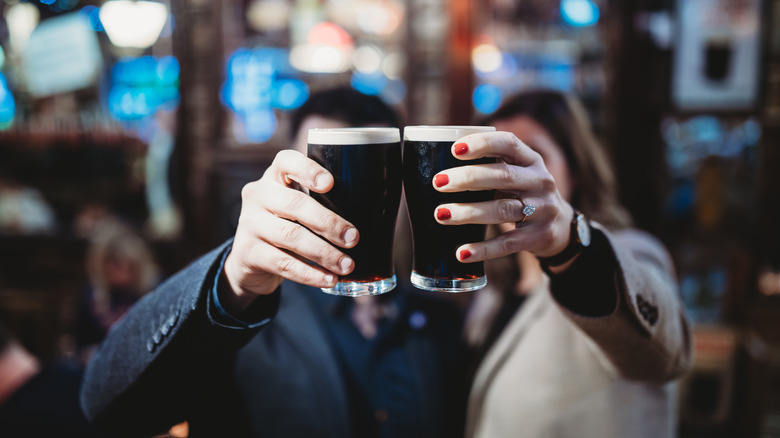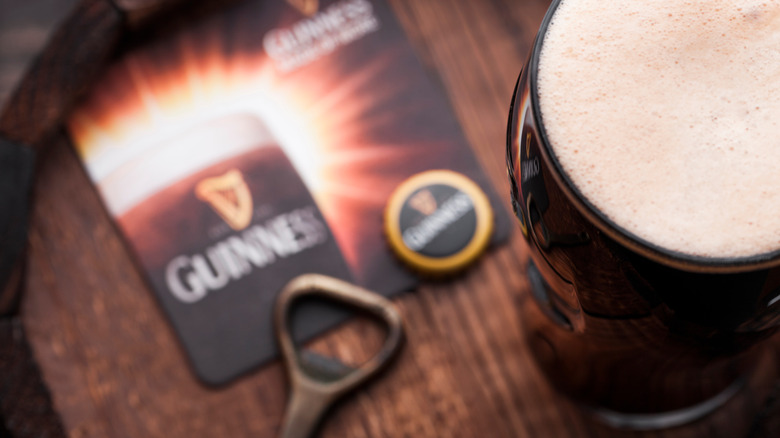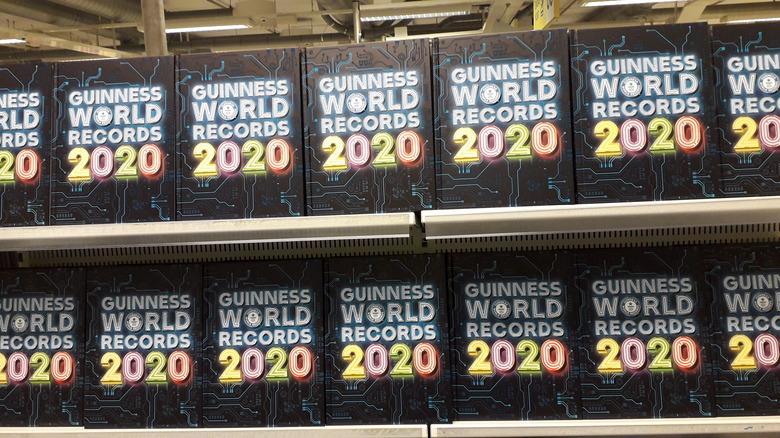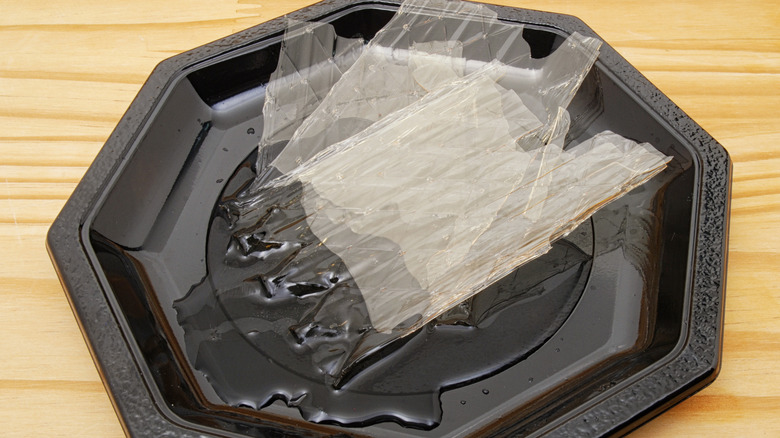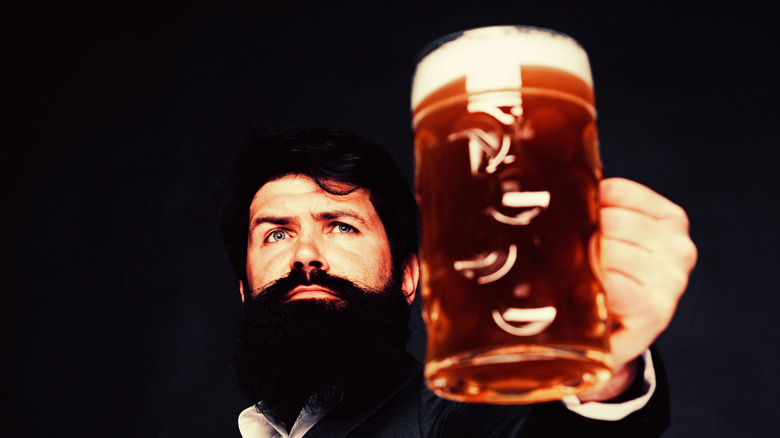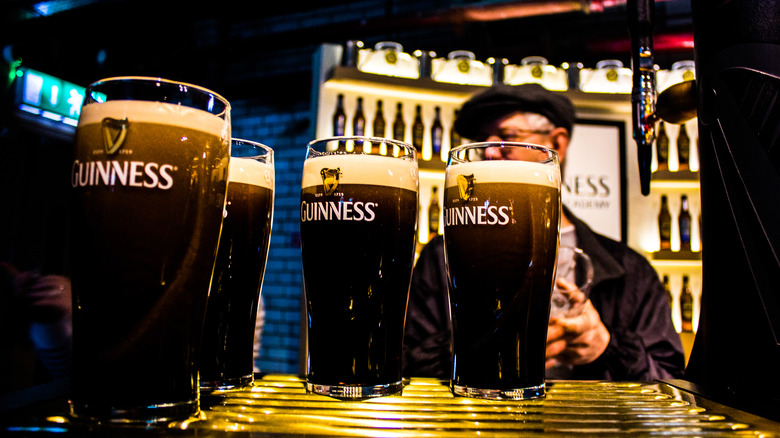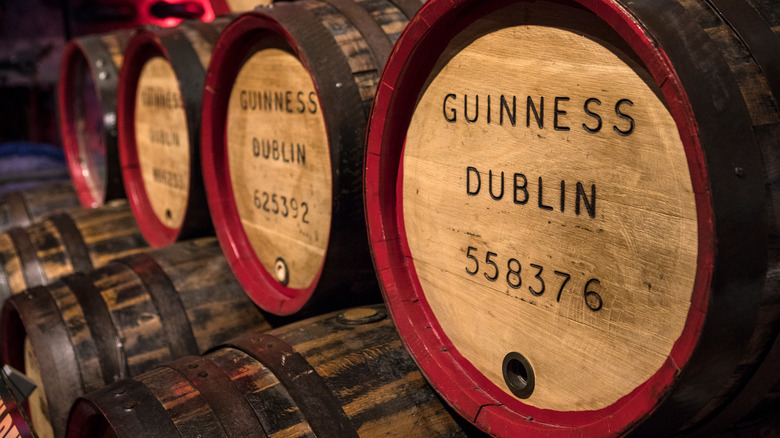The Untold Truth Of Guinness
Guinness is one of the most recognizable beer brands across the globe. In addition to its flagship location in Dublin, Ireland, Guinness is brewed in nearly 50 countries, with approximately 10 million glasses of the stout served each day (via Mental Itch). Today owned by Diageo, a U.K. company formed through a merger of Guinness and Grand Metropolitan in 1997, Guinness has developed a keen following in countries as far as Nigeria, where there are more Guinness drinkers than in all of Ireland (via Smithsonian Magazine).
The story of the popular brew dates back to 1759 when its founding father Arthur Guinness signed a lease on the St. James's Gate Brewery in Dublin. Based on an 1821 recipe, today both Guinness Original and Guinness Extra Stout are some of Ireland's most famous trademarks — next to leprechauns and shamrocks. And despite the fact that Guinness is often referred to as "the black stuff," the beer is actually dark ruby red in color, thanks to one of its main ingredients: roasted malted barley (via Guinness). Keep reading to find out more about this legendary tipple.
Brewed at St. James's Gate in Dublin since the 18th century
The story of Ireland's most iconic beer dates back to 1759 when Arthur Guinness signed a 9,000-year lease on a dilapidated brewery in Dublin. At the time, the four-acre property fetched an annual rent of £45. The St. James's Gate Brewery was so successful that by 1769 Arthur had begun to export his ale to England. He began brewing porter in the 1770s, which was such a hit with beer lovers that in 1799 he decided to stop brewing ale and focus entirely on the creamy stout (via Guinness Storehouse).
One of Arthur's most popular offerings was an export beer called West Indies Porter, a predecessor of today's Guinness Foreign Extra Stout. In 1838 the St. James's Gate Brewery — run by Arthur's son, Arthur Guinness II, at the time — became the largest brewery in Ireland. By 1886, it was the largest brewery in the world. Today St. James's Gate Brewery holds the title of the world's biggest brewer of stout (via Get).
The Guinness Storehouse was the first skyscraper in the British Isles
The Guinness Storehouse, which was built as a fermentation plant for St. James's Gate Brewery in 1902, has been referred to as the first skyscraper in the British Isles. The steel-framed, multistory structure served as the company's fermentation plant until 1988 when it was abandoned in favor of more modern facilities. "The key was turned one day and this grand building was, at a stroke, mothballed. There was still beer running in the pipes when the machines stopped," said Guinness' archive manager Eibhlin Colgan (via Property Week).
Having stood idle for over a decade, the Guinness Storehouse got a new lease on life in the 1990s with the birth of Project Jupiter. Opening as a tourist attraction in 2000, the refurbished building has kept its authentic design and features a number of interesting additions. One of these is an atrium in the shape of a giant pint glass. The other, the Gravity Bar, a glass disc-like structure that offers 360-degree vistas of Dublin. In 2006, Guinness added an extra wing to the storehouse, where visitors can learn about the brand's brewing process (via Ireland Calling).
Each can of Guinness comes with a nitrogen cartridge
If you've noticed a plastic ball rolling around in your empty can of Guinness, you're not the only one. It's a small nitrogen-filled capsule, and it has a very important purpose. While most breweries use carbon dioxide to give beer their fizz, nitrogen creates smaller bubbles, replicating the draught experience (via Guinness). When a Guinness can is opened, the small piece of plastic releases nitrogen gas into the beer, which rises and gives the stout its distinctive thick, silky head (via Insider).
Invented by Guinness in 1969, the widget wasn't incorporated into the brewing process until 1989. The first-generation cartridge had its problems, however. While it worked perfectly with cold beer, it made the brew foam over if served warm. Guinness released its new and improved second-generation widget, called the Smoothifier, in 1997. This little spherical device (it's shaped like a rocket in bottles) is the version of the widget we see in our Guinness cans today (via Insider).
Guinness was the reason the Irish government didn't trademark its coat of arms
The distinctive Guinness logo of a right-facing harp has been a part of Guinness' official trademark since 1862. The golden harp symbol has been inspired by the famous 14th-century Irish harp known as Brian Boru Harp or the O'Neill Harp, which can be found in the library of Trinity College in Dublin. The ornate harp is also the emblem of the Republic of Ireland and once appeared on its coinage (via Irish Central).
As The Irish Times details, around 40 years ago, the office of the attorney general wanted to register the harp as a state symbol with the World Intellectual Property Organization (WIPO). The initial idea was to register the instrument facing in both directions. But since Guinness had already been using a right-facing harp for decades, the Irish government only trademarked a generic, nine-string, left-facing harp in 1984.
There's a perfect way to pour your pint of Guinness
According to Guinness sommelier Padraig Fox, serving the perfect pint of the stout is close to an art form. He specifically refers to the six-step, 119.5 seconds process of pouring Guinness, developed by the brewery (via Typsy). Start by holding a clean, cool, and dry pint glass with the Guinness logo at a 45-degree angle to the tap and fill it up to three-quarters by tapping the handle forward. The beer should then be left to settle before being topped up by pushing the handle backward. The glass should be served with the logo facing the customer or yourself (via The Foodellers).
While there's been a lot of hoo-ha in the media about Guinness' two-part pour, some beer connoisseurs have claimed that the entire procedure is nothing but a clever marketing ploy. Dan Griffin from The Irish Times explains that the "annoying" waiting time for the pint to settle is supposed to make the Guinness feel like a drink worth waiting for and the Guinness drinker like somebody special for enduring this waiting time. The jury is still out on whether there's a good reason behind the brewery's "Good Things Come to Those Who Wait" marketing campaign (via Kegworks).
Guinness can be good for you
Some of the most famous Guinness marketing campaigns over the years have included slogans such as "Guinness for Strength" and "Guinness is good for you" (via Guinness). In fact, the first-ever Guinness advertising waxed lyrical about the brew's numerous health benefits: "Guinness builds strong muscles. It feeds exhausted nerves. It enriches the blood. Doctors affirm that Guinness is a valuable restorative after influenza and other weakening illnesses. Guinness is a valuable natural aid in cases of insomnia." So how true are these statements?
Guinness is a stout, which means that it's made from grain, including roasted barley. And while, just like other beer, it contains antioxidants, vitamin B, soluble fiber, mineral silicon, and prebiotics, it also comes with a slight edge (via CNN). "We showed that Guinness contained the most folate of the imported beers we analyzed," Charlie Bamforth, a professor of brewing sciences at the University of California, told CNN. Guinness is also surprisingly low in calories — 12-ounces of Guinness Draught contains 125 calories, while the same serving of Budweiser has 145 calories. Regardless, it pays to keep in mind that high alcohol consumption has been linked with high blood pressure, liver disease, and pancreatitis.
Guinness has a huge following in Africa
While the popularity of Guinness varies among African nations, the brew makes up approximately 45% of the beer sold by Diageo on the continent, reports Smithsonian Magazine. The majority of the Guinness sold in Africa is Foreign Extra Stout, the same brew the company started exporting back in the 18th century. Compared to regular Guinness that is drunk in the U.S., Foreign Extra Stout is heavier and higher in alcohol content (via CNN).
It's a little-known fact that Nigerians drink more Guinness than the Irish. In fact, when it comes to the amount of Guinness drank, the populous African nation clocks in as the second in the world, just behind the United Kingdom. Perhaps this is due to the fact that Guinness has exported its brews to Nigeria since 1827. To satisfy the demand, there are four Guinness breweries in Nigeria. The other two African Guinness breweries are in Cameroon (the fifth largest consumer of Guinness in the world) and Ghana (via The Irish Post).
Guinness invented the Guinness Book of World Records
The idea for the Guinness Book of World Records was born during an argument between the Guinness Brewery Managing Director Sir Hugh Beaver and his shooting party hosts about Europe's fastest game bird. Unable to find an answer to settle their disagreement, Sir Hugh enlisted the help of researchers to compile a book of facts that would help settle pub arguments. The 198-page first edition of the Guinness Book of World Records, which was published in 1955 in the U.K., took 13 and a half weeks to complete (via Guinness World Records).
Fast-forward 67 years later, and the Guinness Book of World Records is a global hit. With offices in New York, London, Tokyo, and Dubai, the organization receives more than 1,000 applications each week. The appeal of breaking records has proven irresistible, with the book approving over 6,000 records in 2021 alone. In addition, more than 150 million Guinness Books of World Records have been sold to date in over 40 languages, making it one of the most popular publications of all time.
Guinness used fish bladders as a filter until 2018
This may come as a bit of a shock, but until recently, Guinness used isinglass, a protein derived from fish bladders, to reduce excess yeast in its stout. The Vegetarian Resource Group looked into the process in 2016 but wasn't able to find much information on the Guinness website, especially because isinglass is exempt from government labeling requirements. According to the group, isinglass is used in the U.K. due to the climate, which doesn't permit Bavarian-style natural lagering.
In 2017, Guinness started transitioning to a new filtration process that would finally make the brew accessible to vegans. A Guinness representative was quick to confirm that the recipe for the beer had not changed and that the new filtration process wouldn't affect its taste. Unfortunately, some other beer companies may not have followed suit when it comes to eliminating isinglass from their products, and without labeling requirements, they can easily continue the practice without causing suspicion among people who choose not to eat animal-derived products (via Metro).
Thousands of Guinness pints are trapped in facial hair annually
According to research commissioned by Guinness, bearded or mustachioed Guinness fans should consider having a shave before embarking on their next stout adventure. The 2000 study found that the equivalent of around 160,000 pints of Guinness is lost in facial hair in the U.K. alone each year. As a part of the research, Dr. Robin Dover, a specialist in hair science and dermatological conditions, spent two days analyzing the facial hair of eight Guinness tipplers to determine just how much of the good stuff is wasted (via The Guardian).
According to the study, 0.56 milliliters of Guinness is trapped in facial hair with each sip. In addition, it's been estimated that there are around 92,370 Guinness consumers in the U.K., with each one drinking around 180 pints of the stout a year. And since each pint takes around 10 sips to finish, the study proclaimed that 162,719 pints (around $573,000 worth) of Guinness get stuck in beards and mustaches in the U.K. on an annual basis.
Guinness once created its own holiday
Masterminded by Guinness' parent company, Diageo, the first Guinness holiday, Arthur's Day, took place in 2009 to celebrate the 250th anniversary of Arthur Guinness' signing of the lease on the St. James's Gate Brewery. The so-called holiday started innocently enough, with Diageo asking Guinness enthusiasts to raise a pint for the brew's founder Arthur Guinness, at 17.59 (5.59 p.m.) on that day. Within the next few years, Arthur's Day turned into a much bigger celebration with gigs and Guinness promotions run across the Emerald Isle. The 2012 event, for example, was headlined by acts including Fatboy Slim, Tom Jones, and Tinie Tempah (via Slate).
Arthur's Day drew its fair share of criticism, especially as the event gained momentum through its short few years. Referring to the day as "boozy and debauched," Aoife Valentine from The Guardian noted that there was a 30% increase in ambulance pick-ups across Dublin on the night of the 2012 event. Guinness canceled the event in 2013, denying that the decision was due to the criticism that the company promoted irresponsible behavior (via BBC).
Guinness tastes better in Ireland
Sampling a paint of creamy Guinness during a visit to Ireland is almost a rite of passage. And many swear that the brew they've had in the Emerald Isle is far superior to the Guinness pints they drink at the local bar back home. Recently, scientists have shown that there may very well be some truth in these taste testimonies. Scientists from the Institute of Food Technologists conducted Guinness taste tests in 33 cities across 14 countries including Ireland. And the majority of the tasters were adamant that they enjoyed pints of Guinness more in Ireland than in other countries. In fact, the average pint of Guinness consumed in Ireland received a mark of 74 out of 100, as opposed to the average pint score of 57 in other countries (via Irish Central).
So how accurate are these results? I think we can all take them with a pinch of salt. As the celebrated beer author Pete Brown highlights, believing that Guinness tastes different in Ireland may or may not be just in our minds. "Drinking Guinness in Ireland is always going to be more enjoyable than in London or Paris, or anywhere else," he told the Daily Mail. "In Irish pubs, you can order a Guinness knowing that the tap has been flowing all day ... The locals also tend to know their own beer inside out, so you'll get it at the right temperature, in the right glass, and with the right head."
